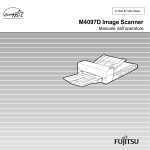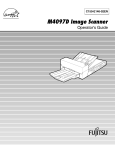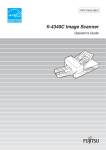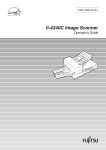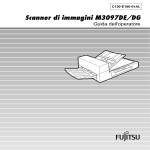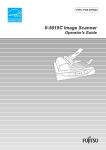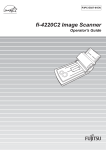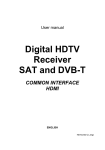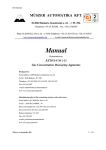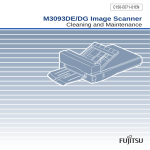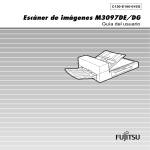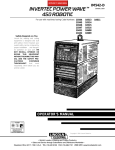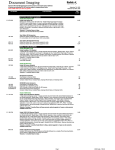Download Fujitsu M4097D User's Manual
Transcript
C150-E146-03EN M4097D Image Scanner Operator’s Guide M4097D Image Scanner Operator's Guide Revisions, Disclaimers Edition Date published Revised contents 01 February, 2000 First edition 02 February, 2000 Second edition 03 May, 2000 Third edition Specification No. C150-E146-03EN This equipment has been tested and found to comply with the limits for a Class B digital device, pursuant to Part 15 of the FCC Rules. These limits are designed to provide reasonable protection against harmful interference in a residential installation. This equipment generates, uses, and can radiate radio frequency energy and, if not installed and used in accordance with the instruction manual, may cause harmful interference to radio communications. However, there is no guarantee that interference will not occur in a particular installation. If this equipment does cause harmful interference to radio or television reception, which can be determined by turning the equipment off and on, the user is encouraged to try to correct the interference by one or more of the following measures: • Reorient or relocate the receiving antenna. • Increase the separation between the equipment and receiver. • Connect the equipment into an outlet on a circuit different from that to which the receiver is connected. • Consult the dealer or an experienced radio/TV technician for help. FCC warning: Changes or modifications not expressly approved by the party responsible for compliance could void the user's authority to operate the equipment. NOTICE • The use of a non-shielded interface cable with the referenced device is prohibited. The length of the parallel interface cable must be 3 meters (10 feet) or less. The length of the serial interface cable must be 15 meters (50 feet) or less. • The length of the power cord must be 3 meters (10 feet) or less. i This Class B digital apparatus complies with Canadian ICES-003. Cet appareil numérique de la classe B est conformme à la norme NMB-003 du Canada. As an ENERGYSTAR ® Partner, Fujitsu Limited has determined that this scanner meets ENERGYSTAR ® guidelines for energy efficiency. ENERGYSTAR ® is a U. S. registered mark. The contents of this manual may be revised without prior notice. All Rights Reserved, Copyright © 2000 FUJITSU LIMITED. Printed in Japan. No part of this manual may be reproduced in any form without permission. ii Fujitsu Offices Please send your comments on this manual or on Fujitsu products to the following addresses: FUJITSU COMPUTER PRODUCTS OF AMERICA,INC. 2904 Orchard Parkway,San Jose. California 95134-2022,U.S.A. TEL:1-408-432-6333 FAX:1-408-432-3908 http://www.fcpa.com/ FUJITSU AUSTRALIA LIMITED Fujitsu Hause 2 Julius Avenue North Ryde N.S.W 2113 AUSTRALIA TEL:61-2-9776-4555 FAX:61-2-9776-4019 http://www.fujitsu.com.au/ FUJITSU CANADA,INC. 2800 Matheson Blvd.East,Mississauga. Ontario L4W 4X5,CANADA TEL:1-905-602-5454 FAX:1-905-602-5457 http://www.fujitsu.ca/ FUJITSU DEUTSCHLAND GmbH. Frankfurter Ring 211, 8000 München 40,F.R,GERMANY TEL:49-89-32378-0 FAX:49-89-32378-100 http://www.fujitsu.de/ FUJITSU ESPAÑA,S.A Edificio torre Europa 5a Paseo de la Castellana 95 Madrid 28046,SPAIN TEL:34-1-581-8000 FAX:34-1-581-8300 http://www.fujitsu-europe.com/home/ FUJITSU EUROPE LTD. 2,Longwalk Road,Stockey Park,Uxbridge Middlesex,UB11 1AB,U.K TEL:44-81-573-4444 FAX:44-81-573-2643 http://www.fujitsu-europe.com/home FUJITSU FRANCE S.A. I, Place des Etats-Unis, SILIC 310, 94588 Rungis cedex, FRANCE TEL:33-1-4180-3880 FAX:33-1-4180-3866 http://www.fujitsu-europe.com/home/ FUJITSU COMPUTERS (SINGAPORE) PTE, LTD. 20 Science Park Road #03-01, Tele Teck Park Singapore Science Park II, Singapore 117674 Republic of Singapore TEL:65-777-6577 FAX:65-771-5669 http://www.fujitsu-computers.com.sg/ FUJITSU HONG KONG Limited 10/F, Lincoln House, Taikoo Place, 979 King’s Road, Island East, Hong Kong TEL:852-827-5780 FAX:852-827-4724 TLX:62667 http://www.fujitsu.com.hk/ FUJITSU ITALIA S.p.A. Via Nazario Sauro, 38 20099 Sestos, Giovanni (MI), ITALY TEL:39-2-26294-1 FAX:39-2-26294-201 http://www.fujitsu-europe.com/home FUJITSU NORDIC AB Kung Hans väg,S-192 68 Sollentuna, SWEDEN TEL:46-8-626-4500 FAX:46-8-626-4588 http://www.fujitsu-europe.com/home FUJITSU LIMITED International Operations Marunouchi 1-6-1, Chiyoda-ku, Tokyo 100 JAPAN TEL:(81-3)3216-3211 FAX:(81-3)3213-7174 TLX:J2283 Cable:”FUJITSU LIMITED TOKYO” http://www.fujitsu.co.jp/ iii Note, Liability READ ALL OF THIS MANUAL CAREFULLY BEFORE USING THIS PRODUCT. IF NOT USED CORRECTLY, UNEXPECTED INJURY MAY BE CAUSED TO USERS OR BYSTANDERS. While all efforts have been made to ensure the accuracy of all information in this manual, FUJITSU assumes no liability to any party for any damage caused by errors or omissions or by statements of any kind in this manual, its updates or supplements, whether such errors are omissions or statements resulting from negligence, accidents, or any other cause. FUJITSU further assumes no liability arising from the application or use of any product or system described herein; nor any liability for incidental or consequential damages arising from the use of this manual. FUJITSU disclaims all warranties regarding the information contained herein, whether expressed, implied, or statutory. FUJITSU reserves the right to make changes to any products herein, to improve reliability, function, or design, without further notice and without obligation. iv Preface This manual explains how to use the M4097D image scanner. This manual contains chapters on the following topics: COMPONENTS INSTALLATION AND CONNECTIONS OPERATING INSTRUCTIONS ADF DOCUMENT SPECIFICATIONS SCANNER SPECFICATIONS SETUP MODE It also contains a Glossary of Terms and an Index. Refer to Cleaning and Maintenance Guide for information about the routine operation of the M4097D. The Reference Guide contains chapters on OPERATING INSTRUCTIONS, CLEANING, REPLACEMENT OF PARTS, ADJUSTMENT and TROUBLESHOOTING. The M4097D is a very fast and highly functional image scanner developed for volume filing, using charge-coupled device (CCD) image sensors. This scanner features duplex scanning and high quality image processing with an automatic document feeder (ADF). v Conventions Important information that requires special attention is indicated as follows: WARNING WARNING indicates that personal injury like pinching of fingers or hands may result if you do not follow a procedure correctly. CAUTION CAUTION indicates that damage to the scanner may result if you do not follow a procedure correctly. Official Fujitsu part names are indicated with an initial capital letter, as in the part name “Pick roller”. NOTICE A NOTICE provides “how-to” tips or suggestions to help you perform a procedure correctly. vi CONTENTS ❑ CHAPTER 1 ❑ CHAPTER 2 ❑ CHAPTER 3 ❑ CHAPTER 4 ❑ CHAPTER 5 ❑ CHAPTER 6 COMPONENTS Checking the Components ............................................. 1-1 Units and Assemblies ..................................................... 1-2 Operator Panel ............................................................... 1-5 INSTALLATION AND CONNECTIONS Precautions ..................................................................... 2-1 Inspection ....................................................................... 2-2 Repositioning the Shipping Lock ..................................... 2-4 Cable Connections ......................................................... 2-5 Mounting the Stacker ...................................................... 2-7 Setting the SCSI ID and the SCSI Terminator ............... 2-8 OPERATING INSTRUCTION Turning the Power On .................................................... 3-1 Waking up the Scanner from the Low Power Mode ....... 3-2 Manual Feed Mode Setting ............................................ 3-3 Loading Documents on the ADF .................................... 3-4 Loading Documents on the Flatbed ................................ 3-9 Loading Documents Larger than the Document Bed .... 3-10 Reading a Page from a Thick Book .............................. 3-11 ADF DOCUMENT SPECIFICATION Document Size ............................................................... 4-1 Document Quality ........................................................... 4-2 ADF Document Feeder Capacity .................................... 4-4 Areas not to be Perforated ............................................. 4-5 Grounding Color Areas ................................................... 4-6 Double Feed Detection Condition ................................... 4-7 Job Separation Sheet ..................................................... 4-8 SCANNER SPECIFICATIONS Basic Product Specification ............................................ 5-1 Installation Specification ................................................. 5-2 Dimensions ..................................................................... 5-3 CONSUMABLES AND OPTIONS Consumables .................................................................. 6-1 Options ........................................................................... 6-2 VIDEO Interface Option .................................................. 6-3 IPC-4D Option ................................................................ 6-8 viivii ❑ CHAPTER 7 ❑ ❑ ❑ viii SETUP MODE Activating the Setup Mode ............................................. 7-1 Contents of the Setup Mode ........................................... 7-2 GLOSSARY OF TERMS ...................................................................... GL-1 INDEX ..................................................................................... IN-1 Declarations of Conformity ................................................................ DE-1 COMPONENTS INSTALLATION AND CONNECTIONS OPERATING INSTRUCTION DOCUMENT SPECIFICATION SCANNER SPECIFICATIONS CONSUMABLES AND OPTIONS SETUP MODE GLOSSARY OF TERMS COMPONENTS INSTALLATION AND CONNECTIONS OPERATING INSTRUCTION DOCUMENT SPECIFICATION SPECIFICATIONS CONSUMABLES AND OPTIONS SETUP MODE GLOSSARY OF TERMS INDEX INDEX ix CHAPTER 1 COMPONENTS This chapter describes the components of the scanner, part names, operator panel arrangement, and the function of parts and LED indicators. After unpacking the scanner, confirm that all components have been received by checking them against the list in the first section. Checking the Components Units and Assemblies Operator Panel 1 Checking the Components These high precision components must be handled carefully. Confirm that all the components shown in the following figure have been received. If any component is missing, please contact your sales agent. Scanner Power cable for North America Power cable for Europe Manuals and Driver Pad ASY 1-1 Units and Assemblies This section shows the exterior view and assemblies of the scanner. This section also provides the name of each part and describes its functions. Units 1 Document cover 4 Operator panel 3 Document holding pad 2 Document bed 5 Stacker 7 Operator panel 9 ADF lever 8 ADF paper chute 12 Third party slot 6 Power switch 11 Interface connector 10 Power inlet M4097D NOTICE The shipping lock must be switched to the operating position before the scanner can be used. Refer to page 2-4. 1-2 No. Function 1 Document cover Closes over and keeps in place the document to be read. 2 Document bed Holds document to be read. Also called Flatbed (FB). 3 Document holding pad Presses document to the Document bed. 4 Automatic document feeder (ADF) Automatically feeds documents to the reading position. 5 Stacker Stacks the read documents. 6 Power switch Turns the power on of off. 7 Operator panel Contains indicator panel that indicates scanner status. 8 ADF paper chute Holds the documents to be fed by the automatic document feeder (ADF). 9 ADF lever Opens/closes the ADF to enable the removal of documents jammed in the feeder. 10 Power inlet Connects to an AC power outlet with the power cable. 11 Interface connectors Connects to the host system with interface cables. 12 Third party slot A Fujitsu Video Interface Option Board is installed. 1-3 Assemblies Thumb screw Guide A ASY Stacker Pick roller 2 Pad ASY Pick roller 1 1-4 Operator Panel The operator panel is located on the upper right hand side of the scanner. The panel consists of an LCD display (16 characters x 2 lines), LEDs and buttons. Arrangement Operator panel Exit Previous Stop Send To/ Start Enter Read Check Next 1-5 Button/LED Function Name of the button and LED Function Button Next Displays the next LCD screen. Previous Displays the Previous LCD screen. Moves the cursor to the left. Moves the cursor to the right. Exit When you are entering settings on the Operator panel, pressing this button returns you immediately to the “ Scanner Ready” screen. Enter Enters the parameter currently selected by the cursor. Send To/ Start Operational only when Manual start mode is set or the “ Read” lamp lights; Starts the reading when video interface option is used. Some application software packages might use this button. Stop When the “ Check” LED lights, pressing this button releases the error status (turns off ” Check” and returns to the “ Scanner Ready” screen). Operational only during the reading operation; stops the reading when the video interface option is used. Also turns off the “ Check” lamp. LED 1-6 Indicates that the scanner is ON. Read Indicates the scanner is reading or ready to read. Check • If lit, this indicates that an alarm occurred. Pressing the “ Stop” button turns the “ Check” lamp off. • If it blinks at one second intervals, this means that a jam or double feed has been detected. If the problem is jammed paper, removing the jammed paper turns off the “ Check” lamp. If the problem is double feed, pressing the “ Stop” button turns off the “ Check” lamp. • If it blinks at four second intervals, this means that cleaning the ADF is necessary. Counter Display The scanner is provided with the counter display. Paper counter Abrasion counter Counter Function Paper counter When the The paper counter counts the number of scanned button is pressed sheets from the start of reading until Paper Empty or an error is detected. The counter is automatically reset at the start of reading. The counter is used for checking the number of the sheets scanned in one batch. When the This counter increments each time a document is button is pressed scanned. It is not initialized until the power is turned off. The counter can be used, for example, for checking the number of sheets that have been scanned in one day. Abrasion counter The abrasion counter counts the accumulated number of scanned sheets. This counter increments every 10 sheets. It is useful to check the cleaning cycle or the parts replacement cycle. How to reset it is described in Chapter 6. NOTICE When the counter value is 0, no number is displayed. 1-7 Operation status The operation status is indicated by the following messages: <Power-on> <Reading> <Waiting for Start> The scanner displays the following screen when waiting for the Start button to be pressed: (Only When the Video Interface Option is installed.) <Cleaning request> When the Pick roller cleaning is necessary, the scanner displays the following on the upper line: When the ADF glass cleaning is necessary, the scanner displays the following on the LCD: Clean the Pick roller or the ADF glass in accordance with the manual, “Cleaning and Maintenance”. 1-8 Temporary error <Hopper empty> This message is displayed if there is no more paper on the ADF paper chute during a read operation in ADF mode. Fill the ADF paper chute with paper. To enable the read operation, press the stop button. <Jam> This message is displayed if a ducument is jammed in the ADF. See “Cleaning and Maintenance” for removing jammed ducuments. <ADF cover open> This message is displayed if the ADF is not closed completely. Close the ADF completely, and enable the read operation. <Double feed error> This message is displayed when the ADF detects the Double feed error. Check the document and re-scan the document. 1-9 Alarm One of the following message is displayed if an error occurs in the scanner. If one of the following error message is displayed, turn the power off and then on again. If the same message is displayed, contact your service representative. <Optical alarm front> <Optical alarm back> <FB mechanism alarm> NOTICE When the total number of sheets scanned by the ADF is less than 100, the message above and the message below are displayed alternately. Remove the bracket (Shipping Lock) that holds the carrier in place. <Motor fuse alarm> <Lamp fuse alarm> 1-10 <Image transfer alarm> <Memory alarm> <EEPROM alarm> <FAN alarm> <IPC Board alarm> 1-11 1-12 CHAPTER 2 INSTALLATION AND CONNECTIONS The chapter describes how to install and connect the scanner. Precautions Inspection Repositioning the Shipping Lock Cable Connections Mounting the Stacker Setting the SCSI ID and the SCSI Terminator Precautions This section describes precautions to follow when installing the scanner. To ensure the longevity and proper functioning of your scanner, do not install the scanner in the places and environments described below. • Place the scanner away from electrical noise sources, strong magnetic fields, and air flow. If the scanner is used near an air conditioner, copying machine, or TV set, the scanner may operate incorrectly. • Keep the scanner out of the sun and away from heaters. These environments may shorten the scanner life or cause hardware failures. • Do not install the scanner in a place where vibrations may occur. This environment may cause hardware failures or may cause the scanner to operate incorrectly. • Do not install the scanner in humid, dusty, or damp places. These environments may shorten the scanner life or cause hardware failures. • Do not place the scanner where liquid spills may occur. • Be aware of static electricity, which can damage the scanner’s sensitive electronic parts. Be sure the flooring and the desk are made of materials that do not generate static electricity. For information on the minimum required size of the installation space, see Chapter 5, “SPECIFICATIONS”. 2-1 Inspection This section describes how to check the labels. Label A Label B Label A (Example; your actual label may differ) 2-2 Label B (Example; your actual label may differ) MODEL M4097D PART NO. CAO2956 -2300 SER. NO. 000003 DATE 1999-12 22 Kg FUJITSU LIMITED Rev. Label A B C * 0 1 2 3 4 5 6 7 8 9 0 1 2 3 4 5 6 7 8 9 0 1 2 3 4 5 6 7 8 9 M 4 0 9 7 D 0 MADE IN JAPAN 0 0 0 0 3 * ANS 2-3 Repositioning the Shipping Lock To keep the scanner from being damaged during shipping, the carrier unit is fixed with a Shipping Lock. After placing the carrier unit where it will be installed, change the position of this Shipping Lock as explained below. 1 Place the image scanner on the edge of the desktop so that the left side of the scanner (where the ADF is attached) extends from the desktop. Do not set the image scanner upside down or on its side. CAUTION Do not let the scanner hang more than 20cm (8 in.) over the edge of the desk. Good less than 20 cm (8 in.) Bad Bad 2 Remove the shipping lock from position A . Then, install the shipping lock at position B . Front side Front side Enlarged Shipping Lock (Position for operation) Bottom view Shipping Lock (Position for storage, position for shipment) Enlarged section A B ADF side A Shipping Lock (Position for shipment) CAUTION Before moving or storing the scanner, make sure that the shipping lock is set to the shipment position to prevent possible damage. Before setting the shipping lock, make sure that the carrier has been returned to the home position. 2-4 Cable Connections This section describes how to connect the cables. Connect the cables as follows: Turning the power switch off Press the “O” side of the power switch to turn the power off. Power OFF Power switch Power ON Connecting the power cable Connect the power cable to the power inlet of the device and a power outlet. Power outlet for North America Power inlet Power cable for Europe 2-5 Connecting the interface cables Connect the SCSI interface cables and secure them. Back of the image scanner Interface cables To the host system NOTICES 1. Factory default for the SCSI terminator is ON. If the scanner is in the middle of the daisy chain or of two devices, turn the scanner termination off via the operator panel. 2. The factory default for the SCSI ID is 5. If the ID of the scanner is the same as the other device, change the ID via the operator panel or change the ID of the other device. 2-6 Mounting the Stacker Mount the stacker using the following procedure. 1 Mount the stacker. Hook the pins on the stacker to the claws on the image scanner. Stacker Claw Pin (inside) 2-7 Setting the SCSI ID and the SCSI Terminator The default of the SCSI ID is 5. The SCSI ID is set by using the Setup mode of the operator panel. The procedure to change the SCSI ID is as follows: 1 Turn the power ON by pressing the “I” side of the power switch (see Figure 1.1). The scanner displays “Scanner Ready” on the lower line of the LCD. 2 Then press the “Next” button. The scanner displays “Mode select 1”. 3 Then press the “Next” button twice. The scanner displays “Mode select 2” meaning that the setup mode is ready. 4 Then press the “Enter” button several times. The scanner displays the following: 5 Press the “Next” button around times, then the scanner displays “SCSI ID” on the upper line of the LCD. 6 Select the wished SCSI ID by pressing the “ set.) ”or “ ” button, and press “Enter”. (the SCSI ID is 7 Press “Exit” to return to “Scanner Ready” screen if you don’t Need to change terminator. NOTICE If no other device is using the same SCSI ID, the scanner ID does not have to be changed. 2-8 NOTICE The new ID does not take effect until the system power is turned on again. 8 Press “Next” , then the scanner displays “Terminator” on the upper line of the LCD. Select “On” or “Off” by pressing or , then press “Enter”. NOTICE The scanner includes a SCSI terminator that can be turned on and off from the operator panel of the scanner. The factory default is “On.” 9 Press “Exit” to return to the “Scanner Ready” state. 2-9 2-10 CHAPTER 3 OPERATING INSTRUCTION This chapter describes how to turn the power on, and gives button specifications and reading mode settings for both ADF and Manual modes, how to load documents onto the ADF and Flatbed, how to load documents larger than the Document bed, and how to read a page from a thick book. Refer to the “Cleaning and Maintenance”manual for routine scanner maintenance. Turning the Power On Waking up the Scanner from the Low Power Mode Manual Feed Mode Setting Loading Documents on the ADF Loading Documents on the Flatbed Loading Documents Larger than the Document Bed Reading a Page from a Thick Book Turning the Power On This section describes how to turn the power on. Press the “I” side of the power switch. The power turns on and the green Power lamp at the operator panel lights. Power OFF Power switch Power ON 3-1 Waking up the Scanner from the Low Power Mode This section describes how to wake up the scanner from the Low Power Mode. To wake up the Scanner, simply press a button, set the papers on the ADF, or send a command to scan from the host computer. NOTICE As an ENERGYSTAR ® partner, Fujitsu Limited declares that this scanner meets the ENERGYSTAR ® guidelines for energy efficiency. 3-2 Manual Feed Mode Setting In this mode, the scanner waits for some predetermined time without issuing a “Paper Empty” message after all documents are read. This predetermined time (time-out limit) is specified in the Setup mode. Therefore you can set the next documents on the ADF chute without interrupting the reading operation. The procedures for setting the manual feed mode are as follows: <Screen M1> 1 Turn the power ON and verify that “Scanner Ready” is displayed on the LCD. <Screen M2> 2 Press then the scanner displays Screen M2. <Screen M3> 3 Press then the scanner displays Screen M3. <Screen M4> 4 Press then the scanner displays Screen M4. 5 Select “Yes” by pressing . Then press . <Screen M1> 6 Press to return to the “Scanner Ready” screen. Note that “Manual Feed” is shown on the LCD. This means that the scanner is in Manual Feed mode. 3-3 Loading Documents on the ADF NOTICE Be sure to change the position of the shipping lock according to “INSTALLATION AND CONNECTION” procedure before operation. ADF paper chute Guide ADF Guide lever ADF lever Stacker 1 Lift the ADF paper chute up and place the shaft in its operating position. Operating position 3-4 Bar 2 Fan the sheets before setting a stack of documents on the ADF paper chute. Document 10mm NOTICES • Remove paper clips and staples. Flatten the staple holes. • Read the following documents using the Flatbed: - Paper with clip or staple. - Paper with wet ink. - Paper of uneven thickness (for example, envelopes). - Paper with large rumples or curls. - Paper with folds or tears. - Tracing paper. - Coated paper. - Carbon paper. - Paper smaller than A8 (portrait) size or wider than A3 size. - Materials other than paper (for example, clothes, sheet metal, or OHP film). - Photographic paper. - Paper with perforations on the side. - Non-rectangular paper. - Very thin paper. • Set documents on the ADF so that the curl of the leading edge does not exceed the measures shown below. More than 30mm Feed direction Less than 3mm Top of the paper Read surface More than 30mm Less than 5mm Top of the paper • To avoid skewing, do no feed docments of different widths during the same batch. 3-5 3 Preparing the Paper • Place the documents face down, with the top to the left as shown in A. (The long side is the top for landscape mode and the short side is the top for portrait mode.) • Holding both ends with both hands, lift the documents. • Hold the documents tightly with your left hand and bend them as shown in B. • Grip the documents tightly with your right hand, loosen the grip of your left hand, and straighten as shown in C. • Even up the feed edge of the batch of paper as shown in D. Top A B AB D C (For portrait mode) C NOTICE Reduce the batch size of the documents if double feed or misspick occurs. 4 Adjust the stacker extension to the paper size, and then flip out the plate. ADF paper chute Stacker 3-6 5 Set the guides so that there is a small clearance between the document edges and the guides. Load the document face down on the ADF paper chute and adjust the guides to the document width. Documents Guide NOTICES • Squeeze the guide lever to free the guides. • Do not load document stacks thicker than 8mm. • Set the guides so that they touch the document sides. Guide lever (Both sides) max. 8 mm (0.32") 3-7 6 3-8 After the read command is issued from the host system and the documents are read, scanned documents are expelled into the stacker for removal. Loading Documents on the Flatbed WARNING Do not look directly at the light source during read operation. Scanner parts involved when loading documents Document cover Document holding pad Document bed 1 2 3 4 Open the document cover. Place the document facedown and align the top left corner with the reference mark. Reference mark Slowly close the Document cover. Issue the read command from the host system. 3-9 Loading Documents Larger than the Document Bed WARNING Do not look directly at the light source during read operation. Document bed Document 1 2 3 3-10 Open the Document cover to an approximately 90 degree angle and slide the cover in the direction of the arrow to remove it. Place the document facedown on the Document bed. Issue the read command from the host system. After the read operation, remove the document, re-attach the Document cover and close it gently. Reading a Page from a Thick Book WARNING Do not look directly at the light source during read operation. Thick book 1 2 3 Open the Document cover. Place the book face down on the Document bed. Issue the read command from the host system. Keep the cover open for reading. NOTICE Do not move the book during the read operation. 3-11 3-12 CHAPTER 4 ADF DOCUMENT SPECIFICATION This chapter describes the document size and document guality required to use the ADF successfully. Document Size Document Quality ADF Document Feeder Capacity Areas not to be Perforated Grounding Color Areas Double Feed Detection Condition Job Separation Sheet Document Size The following figure shows document sizes that the scanner can read using the ADF. Scanner Maximum Minimum A B A B 297 (11.7") 432 (17") 53 (2.1") 74 (2.9") M4097D A3/Double Letter A8 (Portrait) (Unit : mm) 4-1 Document Quality This section describes the types and weights of paper that the scanner can read and precautions in preparing documents to ensure maximal scanner functioning. Document type The recommended paper type for documents is as follows: • Woodfree paper • Plain paper (for example, the paper type specified for XEROX 4024) When using any other type of paper, test feed a few sheets with the ADF to ensure the paper feeds properly before performing a large-scale reading operation. Any paper can be used on the flatbed. However, grand color specification must satisfy the specification described in the Grounding Color Area section. Paper weight The paper weight should fall within the following ranges: • 52 to 127 g/m2 (13.9 to 34 lb), 127g/m2 (34lb) for A8 Precautions A preliminary document feed test may be necessary to avoid unexpected errors. If document slip or jam in the ADF (JAM error) or double feed occurs frequently, read the documents manually using the flatbed. The following documents may be difficult to read properly using the ADF: • Paper with clips or staples. • Paper with wet ink. • Paper without a constant thickness. (like envelopes) • Paper with large rumples or curls. (See NOTE on the next page.) • Paper with folds or tears. • Tracing paper. • Coated paper (for example, some paper used for color printing). • Carbon paper. • Paper smaller than A8 (Portrait) size, or larger than A3 or Double Letter. • Materials other than paper (for example, clothes, metal foil, or OHP film). • Photographic paper. • Paper with notches on its side. • Non-rectangular paper. • Very thin paper. 4-2 CAUTION As there is always a possibility that a document may be damaged when using the ADF, important original documents should never be fed through the ADF. Instead, read them manually in flatbed mode. NOTICES 1. When scanning a translucent document, set the density to light mode. 2. Carbonless papers have a chemical composition that damages the Pad and Pick roller. Therefore, note the following: Cleaning: Replacement of parts: If misspicks occur frequently, clean the Pad and Pick roller in accordance with the “Cleaning and Maintenance” manual. The life of the Pad and Pick roller may be shorter than if PPC paper documents are fed. 3. The leading edge of all documents fed using the ADF should be straightened so the curl of the paper meets the specifications shown below: More than 30 mm More than 30 mm Less than 3 mm Top of the paper Feed direction Feed direction Less than 5 mm Read surface Top of the paper Read surface 4-3 ADF Document Feeder Capacity The number of pages that can be loaded into the ADF chute depends on the paper size and the ream weight. This information is shown in the following graph: 100 100 ADF chute loading (number of pages) 80 B4 60 A3 A4/Letter or smaller 79 67 or Double Letter 50 61 52 50 41 39 40 31 33 25 20 0 52 64 81 104 127 2 ADF Capacity g/m Paper weight conversion table Country Japan US Europe 4-4 Unit kg/ream lb g/m2 45 13.9 52 55 17 64 Conversion 64.6 77.5 90 20 24 27.9 75 90 104 109.8 34 127 135 41.8 157 Areas not to be Perforated Perforations in the shaded areas may cause errors. If you must read data from such a paper, use the flatbed: 113 134 79 Read reference position 10 10 (Unit: mm) 96 Center of sensor arm 23 Center of sensor arm 10 10 12 Top of paper 15 Front side Paper feeding direction Bottom of paper 10 10 5 Center of paper Areas that must not be perforated 4-5 Grounding Color Areas The color of the shaded area shown in Figure should be paper grounding color (white) or drop-out color. If not, turn the white level following OFF when reading. Grounding color (white) or drop-out color area Read reference position Main scanning direction 3 Subscanning direction Read surface Unit: mm Grounding color area 4-6 Double Feed Detection Condition When the double-feed sensor is used, the thickness or the combination of the thickness and the length of the document is subject to the following specifications: 1 2 3 4 Thickness: 0.065 mm to 0.15 mm Paper length accuracy: 1% or less Any black print at the center of the leading edge of the paper is not allowed. (10 mm x 10 mm) No binding holes are allowed within 35 mm of teh middle (halfway point) along the center of the paper. 5 Printing duty: 12% or less 6 The deviation of the amount of transparent light on the base color area should be less than 10%. NOTICE Certain paper types or a certain condition of papers result in lower detection rates in terms of double feed detection. 35 mm 10 mm No printing allowed Paper feeding direction No binding holes allowed 4-7 Job Separation Sheet 1 Shape The Following shows the typical format of the job separation sheet. 15 Top of paper 15 Reading direction Bottom of paper Center of paper Job separation sheet 2 Paper conditions The paper conditions are the same as the specification described before. But the paper width must be A4 or larger (210 mm or larger in width). 4-8 CHAPTER 5 SCANNER SPECIFICATIONS This chapter describes the installation specifications, dimensions, consumables, and options. Basic Product Specification Installation Specification Dimensions Basic Product Specification No. Item Specification Remarks 1 Operating method 2 Image sensor CCD x2 Front/Back 3 Light source Inert Gas (Xenon) Lamp x2 Green 4 Document Size 5 Document Thickness 52 g/m2 (14lb) to 127 g/m2 (34lb) 6 Optical Resolution 400 dpi 7 Maximum Binary Output Resolution5 8 Minimum Grayscale Grayscale level (internal) 9 Simplex Scanning Speed (Engine Speed) Note *2 Duplex ADF (Duplex), Flatbed A8 (Portrait) A3/Double Letter Note *1 100/150/200/240/300/400/600 dpi 100/150/200/240/300/400 dpi Simplex 100/150/200 dpi Duplex 1024 levels (10bit) 50ppm, 200dpi, A4, Portrait 35ppm, 300dpi, A4, Portrait 45ppm, 300dpi, A4, Landscape 90ipm, 200dpi, A4, Portrait 60ipm, 300dpi, A4, Portrait 80ipm, 300dpi, A4, Landscape 10 Halftone patterns Dither/ Error diffusion 11 Capacity of ADF 100 sheets (A4, 64 g/m2(17lb)) 12 Compression MH/MR/MMR Note *4 SCSI-2 High Density 50-pin, Female Third Party Slot Note *6 13 Interface Note *5 Note *3 11 Note *1: The details are described in chapter 4. *2: The actual scanning speed might differ due to host computers’ environment. *3: The maximum number will differ due to the paper thickness. Refer to chapter 4. *4: The scanning speed might be slow. The usage with NO COMPRESSION is recommended. *5: Both SCSI-2 and the Third Party Slot can not be used at the same time. *6: The Power consumption of the boards should be as follows: - In the Low Power Mode: Less than 0.35 A - With IPC-4D option: Less than 1.5 A - Without IPC-4D option: Less than 3.0 A 5-1 Installation Specification The following table lists the installation specifications of the scanner. Item Dimensions (mm) (Without Hopper and Stacker) Weight (kg) Input power Width Height 696 (27.4") 521 (20.5") 234 (9.2") Voltage 100 to 127 VAC, 200 to 240 VAC ±10 % Phases Single-phase Frequency Device status Temperature Humidity 5-2 Depth 22 (48.4 lb.) Power consumption Ambient condition Specification 50/60 ± 3 Hz 160 VA or less Operating Not operating 5 to 35˚ C (41 to 95˚ F) 20 to 80 % Heat capacity 110 kcal/H (442 BTU/H) Shipping Weight (kg) 28 (61.7 Ib) -20 to 60˚ C (-4 to 140˚ F) 445 (17.5") (13.2") 521 234 (9.2") 335 (20.5") Dimensions 696 (27.4") (unit: mm) 5-3 5-4 CHAPTER 6 CONSUMABLES AND OPTIONS This chapter describes the installation specifications, dimensions, consumables, option. Consumables Options Video Interface Option IPC-4D Option Consumables The following table lists consumables used for the scanner. Be sure to keep some consumables in stock. The customer is responsible for changing these items periodically, in accordance with the guidelines given below and in the “Cleaning and Maintenance” manual. If they are not changed as recommended, the scanner may not function properly. The abrasion counter can be used to check the total number of documents scanned since the last replacement(s). Name Specification Remarks Pad ASY PA03951-0151 Up to 100,000 sheets or one year. Pick rollers PA03951-0153 Up to 200,000 sheets or one year. (Two rollers are included.) NOTICE Refer to the M4097D Image Scanner Cleaning and Maintenance manual for replacing the consumables. CAUTION Certain paper types or conditions might reduce the life of consumables. 6-1 Options The following table lists options available for the scanner. Name P/N Video Interface Board Option CA02956-2391 IPC-4D CA02919-0521 Contact your Fujitsu sales agent for more information. 6-2 Remarks Image Processing Circuit One per unit Video Interface Option How to Install the VIDEO Interface Option Board 1 Loosen the two screws to remove the plate. CAUTION Turn off the power before removing the Third Party slot plate. 2 Insert the board along the rails of the third party slot. Make sure that the connector is connected securely. Secure the board with two screws. CAUTION Protective measures are required to prevent damage from static electricity. NOTICE When the scanner power is turned on again, the scanner automatically recognizes the video interface board. 6-3 Reading Mode Setting When the Video Interface Option is Installed This section describes the button specifications and setup details for each of the simplex (front-side), duplex (front-side) and duplex (back-side) reading modes when the scanner has the video interface option in the third party slot. When the reading mode is set by the command from the host computer, the following button operation is not required. NOTICE When the video interface option is installed in the scanner, the scanner automatically recognizes the board and changes the display. Whenever you press , the scanner returns to screen M1. <Screen M1> 1 Turn the power ON and verify that “Scanner Ready” is displayed on the LCD. <Screen M2> 2 Press then the scanner displays Screen M2. 3 Press Screen 1. then the scanner displays <Screen 1> 4 Select ADF or FB by pressing or then press . The scanner displays Screen 2. <Screen 2> 5 Select “Simplex” or “Duplex” by pressing or . Then press Enter. The scanner displays Screen 3. 6-4 <Screen 2> 6 Select “Portrait” or “Landscape” by pressing or . Then press . The scanner displays Screen 4. <Screen 4> 7 Select Size by pressing or . Then press . The scanner displays Screen 5. <Screen 5> 8 Select Resolution by pressing or . As the cursor moves to the left 100/150 may appear. Then press . The scanner displays Screen 6. <Screen 6> 9 Select Front Density by pressing or . As the cursor moves to the right, / may appear. Then press . The scanner displays Screen 7. Density display Without IPC option With IPC-4D option AT1 AT2 Description Very dark Dark * Dynamic Threshold (DTC mode) * Simplified Dynamic Threshold (IPC mode) Normal Light Very light * This parameter appears only when IPC-4D is installed. 6-5 <Screen 7> 10 Select Back Density (when “Duplex” was Selected) by pressing or . As the the cursor moves to the right, / may appear. Then press . The scanner displays Screen 8. <Screen 8> 11 Select Front Halftone by pressing . or Parameter Description No Halftone is “ Off” . Therefore binary reading is specified. H1 Halftone with dither is specified. H2 Halftone with error diffusion is specified. L1 * Automatic separation with dither is specified. L2 * Automatic separation with error diffusion is specified. * This parameter appears only when the IPC-4D is installed. Press to confirm. The scanner displays Screen 9. <Screen 9> 12 Select Back Halftone (when “Duplex” was specified) by pressing or . The parameters are the same as in step 11. Press to confirm. The scanner displays Screen 10. <Screen 10> 13 Select Front Document Type by pressing or . 6-6 Parameter Description L. (Line) White level following is ON. Top 3mm part of the document must be left blank (grounding color is drop-out color). It is useful for reading line arts or texts. P. (Photo) White level following is “ Off” It is useful for reading photographs. Press to confirm. The scanner displays Screen 11. <Screen 11> 14 Select Back Document Type (when “Duplex” was specified) by pressing or . The parameters are same as in step 13. Press to confirm. The scanner displays Screen 12. <Screen 12 (Example)> 15 Confirm what you have specified. If some parameter needs to change, or to select the press corresponding screen and re-select the parameter by pressing or and finally press . If all parameters are acceptable, press to return to the “Scanner Ready” screen. Density Halftone Line Art or Photo Resolution Portrait or Landscape Paper size Front side (F) or Back side (B) Simplex (S) or Duplex (D) 6-7 IPC-4D Option The IPC-4D option performs the image processing. IPC-4D supports following image processing. Item Pre-Filter Background Removal Dynamic Threshold Noise Removal Auto Separation Outline Extract Filter Description Ball-Point Pen Filter : Smooth ball point pen strokes. Remove background tone and light dither. One Pass / Two Pass Dynamic Threshold : Adjust threshold level for binarzing to separate from background. Captures the light text. IPC-2 like Dynamic Threshold : Adjust threshold level for binarizing with preserving sharpness. 2x2 to 5x5 dot removal by matching : Remove isolated dots in size 2x2 to 5x5 pixels. Auto Separation : Automatically, detect text area for binarizing and photo area for dithering. Outline Extract outline of the image Emphasis (Low/High) : Emphasis contour. Smooth : Smoothing image by averaging. NOTICE For the installation and functions of the IPC-4D, refer to the supplied manual. 6-8 CHAPTER 7 SETUP MODE This chapter describes the setup mode of the scanner. Activating the Setup Mode Contents of the Setup Mode Activating the Setup Mode This section describes how to activate the setup mode. <Screen M1> 1 Turn the power ON. Then the scanner displays “Scanner Ready” on the LCD. <Screen M2> 2 If the scanner does not have a video interface option, go to the procedure step 3. Press then the scanner with the video interface option displays Screen M2. <Screen M3> 3 Press then the scanner displays Screen M3. <Screen M4> 4 Press then the scanner displays Screen M4. 5 Press . Now the scanner is at Screen 41 (page 6-3) in Setup mode. NOTICE Any time you press , you can return to the “Scanner Ready” screen. 7-1 Contents of the Setup Mode This section describes the contents of the setup mode. No Item 7-2 Description Selectable parameters Default 1 Double feed check Specifies the double feed detection. Double feed is detected by checking the document length and/or paper thickness.** 2 Length check =No/10/15/20 mm Specifies the document length to enable double feed detection sets the document length. Tolerance: No/10/15/20mm 3 IPC pre-setting Scanner automatically sets the recommended reading parameters. 3 sets of parameters are available when IPC-4D is not installed. Document: No Sharpen Darken No Charactor Copy Quality 4 Resetting of abrasion counter Resets the abrasion counter. - 5 Pick start time setting Specifies the time from document Insertion to the start of picking. User can Time: select the most comfortable Pick start time 0.2 to 29.8 sec for the job. 1.0 sec 6 Time-out limit setting Specifies the time the scanner waits for the next document insertion after the last document was scanned. Time: 27 values from 1 to 1999 sec 30 sec 7 ADF front offset setting* Specifies the horizontal and vertical offset of the front side image when using the ADF. Offset: H:-2 to +3 mm V:-2 to +3 mm Offset: H: 0 mm V: 0 mm 8 ADF back offset setting* Specifies the horizontal and vertical offset of the back side image when using the ADF. Offset: H:-2 to +3 mm V:-2 to +3 mm Offset: H: 0 mm V: 0 mm 9 Flatbed offset setting* Horizontal and vertical offset of the FB image is specified. Offset: H:-2 to +3 mm V:-2 to +3 mm Offset: H: 0 mm V: 0 mm No No - (Continued) Selectable parameters Default The SCSI ID is selectable. SCSI ID: 0/1/2/3/4/5/6/7 5 No Item Description 10 IPC status display The type of IPC option (IPC-4D) is displayed. 11 SCSI ID setting 12 SCSI terminator setting Switch the SCSI terminator On/Off. On/Off On 13 Low Power Mode setting Change the default setting of the duration for power save. 5 min. to 60 min. 15 min. 14 Select Interface Select the interface when the scanner has a board in the third party Slot. Auto/SCSI/Tps Auto 15 Display TPS Board ID Number Display the ID number of the board in the third party Slot. * This offset refers to the difference from the value adjusted by automatic offset adjustment. ** Some restrictions apply to the detection of a double feed. 7-3 1. Setting double feed detection (Paper Thickness) When you set the use of double feed detection, you must set it as follows: <Screen 41> 1 Press or and let the scanner display Screen 41. 2 At Screen 41. Press either the or switch to set the double feed detection according to the paper thickness (transmitted light). The paper thickness is checked using the difference between two consecutive sheets of paper fed from the ADF. On this screen, select whether or not to check for double feeding, and select the error processing. Each time either of these switches is pressed, the location of the blinking moves. When the switch is pressed, the blinking moves from (1) to (3). When the switch is pressed, the blinking moves in the opposite direction. However, if the setting by the host computer is valid, the location of the blinking does not move when either switch is pressed. (1) “No” is blinking: Paper thickness is not checked. (2) “Yes” and “1” are blinking: Paper thickness is checked. However, a detected double feed error is displayed on the screen only; processing is continued. (3) “Yes” and “2: Stop” are blinking: Paper thickness is checked. When the double feed error is detected, the scan processing is stopped. The error is then reported to the host. If you want to disable the double feed, select “No” then press . Press to return. NOTICES 1. Double Feed detection might have better results when the paper thickness and both paper length are used. 2. When the document in ADF is not the double fed document, the previous document might be double fed, in case the scanner stops feeding by using the double feed detection. 3. Depending on the type of printing on the document, a double feed may not be detected by the paper thickness. 7-4 2. Setting double feed detection (Paper Length) <Screen 42> 1 Press or and let the scanner display Screen 42. 2 Press either the or switch to set double feed detection according to paper length. The paper length is checked using the difference between two consecutive sheets of paper fed from the ADF. Each time either of these switches is pressed,the location of the blinking moves. When the switch is pressed, the blinking moves from (1) to (3). When the switch is pressed, the blinking moves in the opposite direction. However, if the setting by the host computer is valid, the location of the blinking does not move when either switch is pressed. (1) “No” is blinking: Paper length is not checked. (2) “Yes” and “1” are blinking: Paper length is checked. However, a detected double feed error is displayed on the screen only; processing is continued. (3) “Yes” and “2: Stop” are blinking: Paper length is checked. When the double feed error is detected, the scan processing is stopped. The error is then reported to the host. If you want to disable the double feed, select “No” then press . Press to return. After pressing , the scanner displays the screen 42-1. <Screen 42-1> 3 Press either the or switch to set double feed detection (paper length). When the switch is pressed, the blinking moves from (1) to (3). When the switch is pressed, the blinking moves in the opposite direction. (1) The “10” is blinking: Threshold is 10mm (2) The “15” is blinking: Threshold is 15mm (3) The “20” is blinking: Threshold is 20mm 7-5 3. Setting IPC pre-set mode When you set the use of the IPC pre-set mode, you must set it as follows: 1 Press “Next” or “Previous” the scanner display Screen 43. and let <Screen 43> NOTICES Following 2PC Pre-setting can be selected when 2PC-4D is installed. Preset 1: Capture texts in the colored background Preset 2: Produce good contrast image Preset 3: OCR Smoothing Preset 4: Image Smoothing Preset 5: Dither Following built-in IPC Pre-setting can be selected even though IPC-4D is not installed. 2 At Screen 43, press or to select the pre-Setting and press to activate the pre-setting. Then the scanner displays Screen 43-1. <Screen 43-1> 3 At Screen 43-1, select “Yes” or “No”. Note that when you select “Yes”, the IPC setting from the Host computer is ignored. If you select “No”, the IPC setting will be changed according to the host setting. Finally press . NOTICE When you select the Copy Quality, select the scanner and printer settings carefully to get the best quality. 7-6 4. Reset of the abrasion counter When you reset the abrasion counter, you must set as follows: 1 Press “Next” or “Previous” the scanner display Screen 44. and let <Screen 44> 2 At Screen 44; If you want to reset the abrasion counter, select “Yes” through or button and press . Go to procedure 3. If you do not want to reset the abrasion counter, select “No” and press . Finally press to return. <Screen 44-1> 3 At Screen 44-1; If you want to reset the abrasion counter, select “Yes” and press . If you do not want to reset it, select “No” and press . Press to return. 5. Setting the pick start time When you set the pick start time, you must set it as follows: 1 Press “Next” or “Previous” the scanner display Screen 45. and let <Screen 45> 2 At Screen 45, press to increase the Pick start time or press to decrease the Pick start time. Then press to activate the setting. Finally press to return. 7-7 6. Setting the time-out limit 1 Press “Next” or “Previous” the scanner display Screen 46. and let <Screen 46> 2 At Screen 46, press to increase the number or press to decrease the timeout limit. Then press to activate the setting. NOTICE Default is 30 seconds. 3 Press to return. 7. ADF Front Offset Setting 8. ADF Back Offset Setting 9. Flatbed Offset Setting <Screen 47> 1 Press “Next” or “Previous” and let the scanner display the following: • Front Offset by ADF : Screen 47. • Back Offset by ADF : Screen 48. • Offset of the Flatbed: Screen 49. <Screen 48> <Screen 49> <Screen A> or 2 Select “Yes” by pressing the button, then press . The scanner displays Screen A. 7-8 <Screen B (Example of ADF Front Offset)> 3 At Screen A, if you want to let the offset return to default, select “Yes” otherwise “No” then press . The scanner displays Screen B. <Screen B (Example of ADF Back Offset)> <Screen B (Example of FB Offset)> <Screen C (Example of ADF Front Offset)> 4 At Screen B, press to increase the offset or press to decrease offset. The increment or decrement is 0.5 mm. Then press to activate the setting. The scanner displays Screen C. <Screen C (Example of ADF Back Offset)> <Screen C (Example of FB Offset)> 5 At Screen C, press to increase the offset or press to decrease the offset. Then press to activate the setting. The scanner displays the next item of the setup mode. 7-9 10.IPC Status Display <Screen 50> (An example) 1 Press “Next” or “Previous” the scanner display Screen 50. and let <Screen 50-1> 2 Screen 50 displays the IPC option installed and the total image memory installed. 3 Press to return. 11.SCSI ID Setting <Screen 51> 1 Press “Next” or “Previous” the scanner display Screen 51. 2 At Screen 51, press SCSI ID. Then press setting. 3 Press or and let to select to activate the to return. 12.SCSI Terminator Setting <Screen 52> 1 Press “Next” or “Previous” the scanner display Screen 52. 2 At Screen 52, press or Terminator. Then press the setting. 3 Press 7-10 to return. and let to select to activate 13.Low Power Mode Setting <Screen 53> 1 Press “Next” or “Previous” the scanner display Screen 53. and let <Screen 53-1> 2 Pressing the and press Screen 53-1. or button, select “Yes” . The Scanner displays 3 At Screen 53-1, press or to select the time duration. The minimum 5 min: to the maximum 60 minutes can be selected. Then press to activate the setting. NOTICE 1. At Screen 53, “No” does not mean that you can turn off the “Low Power Mode”. 2. The default time recommended by the ENERGYSTAR ® program is 15 minutes. The default for the M4097D scanner is 15 minutes, as recommended. 4 Press to return. 7-11 14.Select Interface <Screen 54> 1 Press “Next” or “Previous” the scanner display Screen 54. and let NOTICE The screen 54 will appear oniy when the scanner has proper interface boards or option boards in the third party slot. 2 At Screen 54, press interface type. Press change the setting. or to select the if you want to NOTICES 1. Normally, this setting does not have to be changed. 2. When an appropriate board is installed in the third party slot of the scanner, the scanner automatically turns off the SCSI interface, activating the board in the third party slot. Screen 54 can be used to forcibly change the selected interface. The selected interface is then forcibly changed. 3. The SCSI interface and the board installed in the third party slot cannot be used at the same time. 4. The default is Auto. 3 Press 7-12 to return. 15. Display the TPS Board ID Number <Screen 55> (An Example) 1 Press “Next” or “Previous” the scanner display Screen 55. and let The scanner displays the ID number if the applicable board is installed. NOTICE If the Fujitsu video Interface Option board is installed properly, the display shows “ID=7”. 2 Press to return. 16. Select Built-In/IPC-4D Image Processing <Screen 56> or and let the scanner 1 Press ”Next” display the Screen 56. 2 At the Screen 56, press ”Standard” or ”IPC-40”. or to select When the ”Standard” is selected, the scanner users the built-in image processing that scanner has. On the other hand, the scanner selects the image processing from IPC-4D when ”IPC-4D” is installed and selected. NOTICE The factory default is ”IPC-4D”. 7-13 NOTICE M4097D has built-in Image Processing. The following image processing is supported both by the M4097D and the IPC-4D. As a default, the scanner built-in functions are enabled. By setting "On" the Operator Panel, the IPC-4D image processing overrides the built-in functions. Image Processing 1 Emphasis/Smoothing 2 Outline 3 Simplified Dynamic Threshold IPC-4D M4097D 5 x 5 matrix Pre-threshold raplacian IPC-2 like SDTC Matrix 3 x 3 raplacian 3 x 3 max-min The IPC-4D support of those functions is intended for compatibility with the IPC-3/3D. The matrix size used in the IPC-4D is large. The M4097D Built-in Dynamic Threshold is a new algorithm. 7-14 GLOSSARY OF TERMS A4 size A standard paper size. Paper size is 210 x 297 mm. A5 size A standard paper size. Paper size is 148 x 210 mm. A6 size A standard paper size. Paper size is 105 x 148 mm. A7 size A standard paper size. Paper size is 74 x 105 mm. A8 size A standard paper size. Paper size is 53 x 74 mm. Abrasion counter Counts the cumulative number of documents read to indicate when belts/rollers should be replaced. The number of read documents accumulates until an operator resets the counter. The counter should be reset when these consumables are replaced. ASCII The acronym for American Standard Code for Information Interchange. ASCII is a set of 256 codes (numbered 0 to 255) used to communicate information between a computer and another device such as a scanner. Automatic separation An image processing method in which the scanner automatically detects difference between text and photos, and chooses the threshold accordingly. Automatic separation allows the scanner to switch between line mode and half tone mode in one pass. Automatic start mode (<-> manual start mode) In this mode, the reading operation is activated only by issuing the the START command. Backside reading = Back-side scanning Refers to reading the backside of the document, specifically in Duplex reading mode. GL-1 Bit The smallest unit of information in computer memory. A bit is a single digit, either a 1 or a 0, in the binary numbering system. Eight bits equal one byte. Density In this manual, refers to a measurement of the depth of the display. Dither Technique for producing halftone images by representing the entire grayscale with only two pixel levels, black and white. Double feed detection A scanner function which detects the accidental feeding of multiple sheets by the ADF unit. Can be turned on or off by the operator. Double Letter Size A standard paper size used in the U.S.A. and othe countries. Paper size is 11 x 17 inches. dpi Dots per inch. Dropout color A color which is used in the document but does not appear in the read image. Duplex reading mode A reading mode in which both sides of the document are read. Equipment Error An error that cannot be corrected by the operator. Call CE. GL-2 Error diffusion High-quality halftone (pseudo-grayscale) image production based on black-and-white pixel binarization. A pixel’s optical density and that of adjacent pixels are summed, with black pixels relocated in their order of density as they relate to adjacent pixels. The purpose of this technique is to minimize the average error between read and printed densities. Density data for adjacent pixels is modified by diffusing errors on the objective pixel into several pixels, which are then binarized. This maintains high grayscale levels and resolution during reading, while suppressing more patterns by dotted halftone images such as newspaper photographs. FB In this manual, FB means flat bed. Filtering A correction method that improves the read quality of handwritten documents. The read quality of images written in pencil or ball-pointed pen depends on the reflective light characteristics of the specific ink or lead used. Dropped pixels may produce outlines, gaps, or thin, barely connected lines due to uneven optical density. Filtering detects areas lighter than their surroundings and increases their density to improve image clarity. Front-side reading = Front-side scanning Refers to reading the front side of the document, specifically in Duplex reading mode. Halftone processing Any method used to reproduce a photograph which includes a shade as an image composed of dots, namely, a binary image. Dithering and error diffusion processing are examples of halftone processing. Hexadecimal A base-16 numbering system (also commonly referred to as hex numbers). Since a base-16 system requires 16 digits, numbers 0 through 9 and letters A through F are used. It is convenient to express binary numbers in hexadecimal because fewer digits are required. Image emphasis Density is decreased for lighter but not completely white areas adjacent to black areas. Weakening this emphasis eliminates spot noise or produces softened images. GL-3 Image processing An image is read with specified parameters. Interface The connection that allows communication from one part of a system to another. For example, electrical signals are transferred between the computer and scanner over an interface cable. Inversion (Reverse-image reading) In reverse-image reading, data is changed from black to white and vice versa. IPC preset mode While reading binary images, it is necessary to set the scanner according to the quality of the sheet to be read. In this mode, these settings can be performed in advance by corresponding each setting to a pattern number. IPC-4D Image processing option of this scanner. IRAS Initialization of the hardware. Landscape orientation A document is transported and read with the long side vertical to the moving direction. Letter size A standard paper size used in the U.S.A. and other countries. Paper size is 8-1/2 x 11 inches. Linedrawing mode Selecting linedrawing mode makes threshold and contrast settings effective but prevents brightness from being set. The specified threshold value determines whether black or white pixels are scanned. Line drawing mode is therefore appropriate for scanning text and line art images. Manual Feed mode = Manual Mode Requires the operator to feed each document manually into the ADF paper chute. GL-4 Manual start mode (<-> automatic start mode) The reading operation is activated by pressing the START button in this mode. Available only when video option board is installed. Mirror image The read image is symmetrically flipped to produce a mirror image of the original detected in the main scanning direction. Noise removal Isolated noise from an image appearing as black spots in white areas and voids in black areas is removed to improve image quality. Operator panel A panel containing the scanner indicators and buttons. The operator panel is used to control scanner operations such as loading document, selecting features, and changing setup options. Outline extraction The boundary between black and white areas is traced and the outline extracted for closed areas. PAPER JAM A warning informing the user that document is jammed in the transport unit, or that transportation is disabled because the transport unit is slippery. This warning also appears when a double feed is detected. Photograph mode (White level follower OFF) Selecting photograph mode makes brightness and contrast settings effective but prevents the threshold from being set. With photograph mode, the darkness of image corresponds to the black-pixel density, making it suitable in scanning images such as photographs having gradations. Photo mode = photograph mode A photograph is read properly in this mode. Pick start time The period from the manual insertion of the document until picking starts after the document passes the hopper empty sensor. GL-5 Portrait orientation A document is transported and read with the long side parallel to the moving direction. Paper counter Indicates the total number of read document from start of reading until the hopper becomes empty. Read operation Refers to the reading operation including Simplex reading and Duplex reading. RS-232C interface A type of serial interface. See Serial interface. SCSI-ID Used to specify a particular SCSI device when the initiator selects a target or the target reconnects to the initiator. Serial interface A standard computer interface. Information is transferred between devices over a single wire (although other wires are used for control). With a serial interface, an interface cable greater than 3 meters (10 feet) can be used. This is often necessary in networking environments, where the scanner may be shared. SETUP mode In this mode, users can view or set a variety of function in off-line. Simplex reading mode Only the front side of the document is read in this mode. Place the documents face up at the center of the hopper table. Smoothing A process that eliminates “jaggies” from slanted lines and curves. Irregular convexities are deleted and irregular concavities filled in. This is useful in OCR applications, for example. GL-6 Temporary Error An error correctable by the operator. Terminator Devices with a SCSI interface can be daisy-chained. A resistor that includes terminal circuits needs to be placed at both ends of a cable when devices are daisy-chained. If a device (such as a scanner) is the last device in a chain, leaving an interface connector unused, a Terminator theerfore must be attached to provide those terminal circits. Third Party Interface Optional board provided by Fujitsu or interface board provided by a third party can be installed and used. Time-out limit This is the time the scanner waits for next document insertion after the last document feeding. The scanner returns Paper Empty when no document is set after time-out limit. TPS Third Party Slot. GL-7 GL-8 INDEX A B C D A3 3-3 A4 3-3 Abrasion counter 1-7 Activating the Setup mode ADF 1-2, 1-3 ADF lever 1-2, 1-3 mode 1-6 paper chute 1-2 Alarm 1-10 Ambient condition 5-1 Arrangement 1-5 Assemblies 1-4 Belt 5-3 Button /LED Function Double feed check 6-2 feed detection 6-3 feed error 1-9 Duplex reading mode 3-2 (backside) reading mode (frontside) reading mode 7-1 1-6 Cable connection 2-5 Carrier fixing bracket 2-4 Checking the components 1-1 Connecting the interface cable 2-6 the power cable 2-5 Consumables 5-3 Contents of the Setup mode 6-2 Conventions iii E ENTER button 1-6 EXIT button 1-6 F Feeding direction H Halftone processing Heat capacity 5-1 Hopper empty 1-9 I 3-2 3-2 4-1 3-4 Image processing circuit 5-4 IMPORTANT NOTE TO USERS input power 5-1 Inspection 2-2 Installation specifications 5-1 Interface connectors 1-2, 1-3 IPC presetting 6-2, 6-4 status 6-2, 6-9 i Density 3-3, 3-4 Dimentions 5-1, 5-2 DLT (Double letter) 3-3 Document bed 1-2, 1-3 holding pad 1-2, 1-3 Quality 4-2 Size 4-1 type 3-5, 4-2 IN-1 L M IN-2 Label A 2-2 B 3-3 Landscape orientation LCD 1-5 LCD Display 1-6 LED 1-6 LG (Legal) 3-3 LT (Letter) 3-3 Power cable 1-1, 2-5 consumption 5-1 inlet 1-2, 1-3 switch 2-5, 3-1 Precautions 2-1, 4-2 Previous button 1-6 3-2 Manual feed mode 3-6 start mode 1-6 Memory cover 1-2, 1-3 status 6-2, 6-9 N Next button O Offset setting 6-2, 6-7 Operation status 1-8 Operator’s Guide 1-1 Operator panel 1-2, 1-5 Option 5-4 P Pad Assembly 5-3 Paper counter 1-7 direction 3-2 weight 4-2 Preface ii Pick roller 1-4, 5-3 start time 6-2, 6-6 Plain paper 4-2 Portrait 3-2 R Reading mode 3-2 face 3-2 Resetting abrasion counter 6-6 Resolution 3-3 Reviewing the IPC/Memory Status S Scanner 1-1 Setting double feed detection 6-3 IPC preset mode 6-4 Offset 6-7 picking start time 6-6 SCSI-ID 6-9 time-out limit 6-7 Setup mode 6-1, 6-2 Simplex 3-2 Size 3-3 Specifications 5-1 Stacker 1-2, 2-7 Start button 1-5, 1-6 Stop button 1-5, 1-6 T Terminator 1-1 Temporary error Third party slot Turning the power on the power off 1-6 1-9 1-2, 1-3 3-1 2-5 6-9 U Units 1-2 Units and Assemblies W Weight 1-2 5-1 (Left Arrow Key) button 1-6 (Right Arrow Key) button 1-6 (Next) button 1-6 (Previous) button 1-6 (Send To) button 1-6 (Start) button 1-6 (Stop) button 1-6 (Enter) button 1-6 (Exit) button 1-6 IN-3 Declarations of Conformity DE-1 DE-2 This manual uses recycled paper.






































































































